

 为什么MISRA要求你不要使用位域-本文告诉你真相
为什么MISRA要求你不要使用位域-本文告诉你真相
描述
为什么MISRA要求你不要使用位域-本文告诉你真相 (qq.com)
一.前言
做过嵌入式开发的一般会看到一条编程规范:”不要使用位域”,一般都是知其然不其所以然,了解的多一点的可能知道位域是实现相关不具备可移植性,那么继续追问哪些行为是实现相关哪些行为导致移植性问题? 或者还有人知道,存储布局,对齐等行为是实现相关会导致不可移植性。如果再追问位域产生的汇编代码是什么样的,怎么进行读-修改-写操作的?知道这些内容的就更加少之又少了。 读写肯定不能读指定位数,只能字节,或者16位,32位这种,那么编译器到底读写用什么宽度? 这时基本大部分人都不知道了。
知其然知其所以然,尤其是嵌入式开发和硬件结合比较紧密,所以一定要了解细节,我们这一篇从一个问题引出然后去分析查找原因,只有遇到问题然后去分析解决它才会有更深刻的映像。
二.问题分析过程
问题是驱动程序中一个寄存器的某个位域修改,导致其他位域的值被修改了。
关键代码如下,
1.typedef union nfc_ena_union {
2. uint32_t w;
3. struct {
4. /* spi enable, once the spi trans is completed, this bit will be cleared by HW automaticlly */
5. uint32_t nfc_ena:1; // [0]
6. uint32_t reserved_0:3; // [1,3]
7. /* sw request to use dp */
8. uint32_t nfc_dp_req:1; // [4]
9. uint32_t reserved_1:3; // [5,7]
10. /* due to delay in receiving data, nfc delay one beat to rx */
11. uint32_t nfc_rx_delay_en:1; // [8]
12. uint32_t reserved_2:7; // [9,15]
13. /* spi trans data length, unit is byte,once the spi trans is completed, this bit will be cleared by HW automaticlly */
14. uint32_t nfc_data_len:16; // [16,31]
15. } _b;
16.} nfc_ena_u;
1./**
2. * fn int nfc_set_datalen(uint8_t id, uint16_t len)
3. * param[in] id port id
4. * param[in] len data len
5. * retval 0 ok
6. * retval <0 param err
7. *
8.*/
9.NFC_INLINE int nfc_set_datalen(uint8_t id, uint16_t len)
10.{
11. if(id >= HW_NFC_PORT_MAX)
12. {
13. return -1;
14. }
15. nfc_base[id]->nfc_ena._b.nfc_data_len = len;
16. return 0;
17.}
执行之前该寄存器值为0x00020100
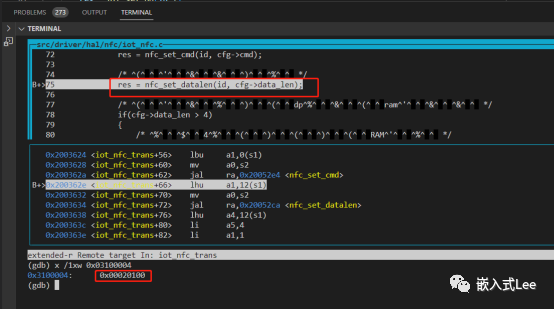
nfc_base[id]->nfc_ena._b.nfc_data_len = len
汇编代码被优化为了写高16位
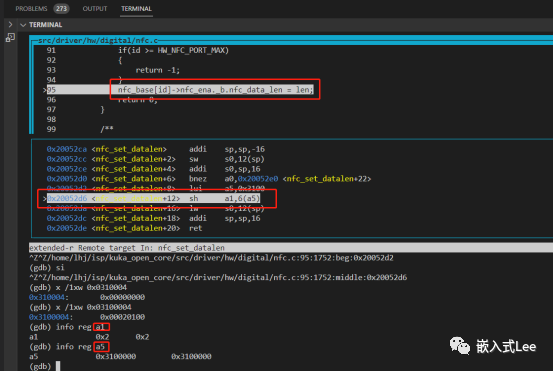
执行完后寄存器低16位变为了0
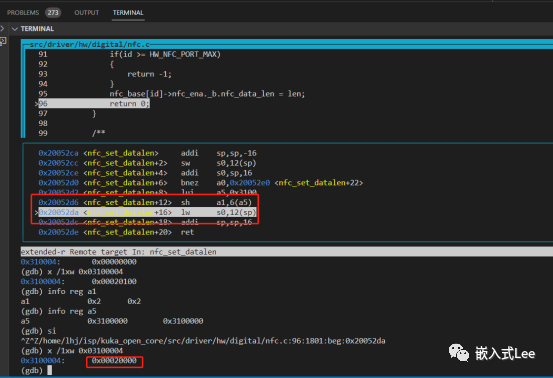
这是因为寄存器硬件上只支持32位的写操作,所以写高16位导致低16位清零了,这是硬件决定的。
二.验证
一般想到的就是优化相关,加volatile等,我们分别验证下。
3.1不使能编译器优化
编译器优化选项改为”-O0”
代码不变
依然会按照16位访问,导致低16位被清掉。
所以可以看到这个和编译器行为有关,编译器显然不是根据优化等级决定位域的操作宽度,这里而是根据位域的宽度刚好是16位对齐,所以优化为了16位操作指令。
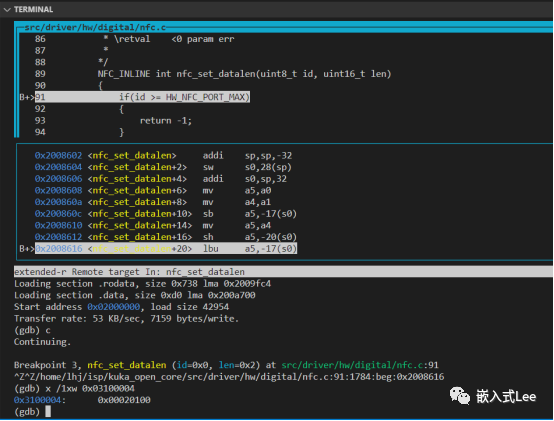
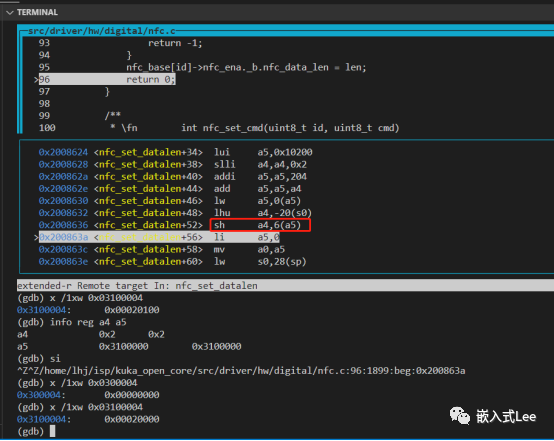
3.2使用volatile避免编译器优化
#ifndef __IOM
#define __IOM volatile
#endif
所有uint32_t替换为__IOM uint32_t
还是一样的
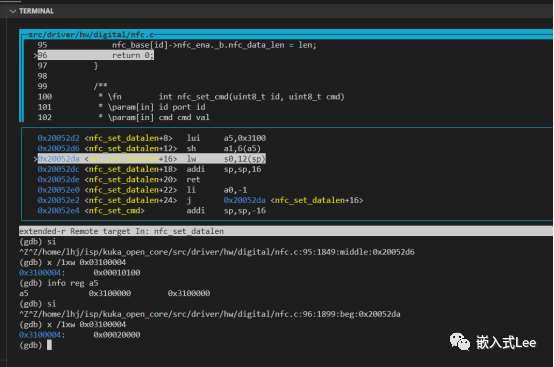
显然汇编代码的访问宽度也不受volatile影响。
3.3为什么指定了uint32_t和volatile还会优化。
问题来了为什么告诉了编译器是uint32_t和volatile,为什么其还要一意孤行,要优化为16位访问指令呢,答案就是因为是标准没有规定,这是编译器实现行为决定的,所以编译器设计者决定的(当然也会有一些现实考虑的),可能不同编译器行为不同,这里以GCC为例。
GCC编译器文档中可以找到答案
GCC的文档可以看到如下内容,也给出了最好是不使用位域的原因


另外也介绍了位域哪些行为也是编译器实现相关的,所以嵌入式可移植性考虑不要使用位域

那么有没有办法指定编译按照一定大小访问呢,GCC有编译选项可以控制见下一节。
3.4使用编译器选项-fstrict-volatile-bitfields

可以看到改为了sw指令,按照32位进行了操作
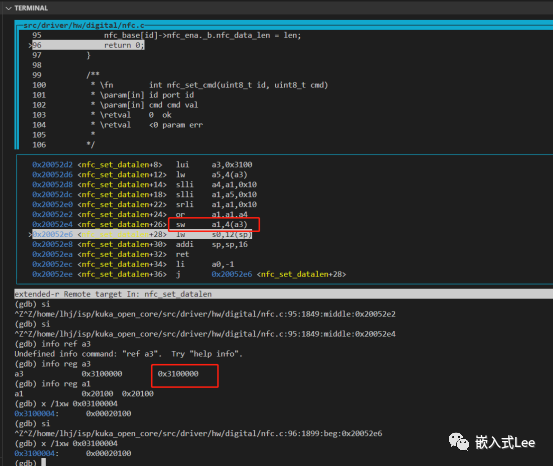
四.一些厂家做法
如下可见
4.1CMSIS
core_cmxx.h中定义
CMSIS中进行了定义,寄存器个别使用位域
1./* IO definitions (access restrictions to peripheral registers) */
2./**
3. defgroup CMSIS_glob_defs CMSIS Global Defines
4.
5. < strong >IO Type Qualifiers< /strong > are used
6. li to specify the access to peripheral variables.
7. li for automatic generation of peripheral register debug information.
8.*/
9.#ifdef __cplusplus
10. #define __I volatile /*!< Defines 'read only' permissions */
11.#else
12. #define __I volatile const /*!< Defines 'read only' permissions */
13.#endif
14.#define __O volatile /*!< Defines 'write only' permissions */
15.#define __IO volatile /*!< Defines 'read / write' permissions */
16.
17./* following defines should be used for structure members */
18.#define __IM volatile const /*! Defines 'read only' structure member permissions */
19.#define __OM volatile /*! Defines 'write only' structure member permissions */
20.#define __IOM volatile /*! Defines 'read / write' structure member permissions */
1.
/**
2. brief Structure type to access the Instrumentation Trace Macrocell Register (ITM).
3. */
4.typedef struct
5.{
6. __OM union
7. {
8. __OM uint8_t u8; /*!< Offset: 0x000 ( /W) ITM Stimulus Port 8-bit */
9. __OM uint16_t u16; /*!< Offset: 0x000 ( /W) ITM Stimulus Port 16-bit */
10. __OM uint32_t u32; /*!< Offset: 0x000 ( /W) ITM Stimulus Port 32-bit */
11. } PORT [32U]; /*!< Offset: 0x000 ( /W) ITM Stimulus Port Registers */
12. uint32_t RESERVED0[864U];
13. __IOM uint32_t TER; /*!< Offset: 0xE00 (R/W) ITM Trace Enable Register */
14. uint32_t RESERVED1[15U];
15. __IOM uint32_t TPR; /*!< Offset: 0xE40 (R/W) ITM Trace Privilege Register */
16. uint32_t RESERVED2[15U];
17. __IOM uint32_t TCR; /*!< Offset: 0xE80 (R/W) ITM Trace Control Register */
18. uint32_t RESERVED3[29U];
19. __OM uint32_t IWR; /*!< Offset: 0xEF8 ( /W) ITM Integration Write Register */
20. __IM uint32_t IRR; /*!< Offset: 0xEFC (R/ ) ITM Integration Read Register */
21. __IOM uint32_t IMCR; /*!< Offset: 0xF00 (R/W) ITM Integration Mode Control Register */
22. uint32_t RESERVED4[43U];
23. __OM uint32_t LAR; /*!< Offset: 0xFB0 ( /W) ITM Lock Access Register */
24. __IM uint32_t LSR; /*!< Offset: 0xFB4 (R/ ) ITM Lock Status Register */
25. uint32_t RESERVED5[6U];
26. __IM uint32_t PID4; /*!< Offset: 0xFD0 (R/ ) ITM Peripheral Identification Register #4 */
27. __IM uint32_t PID5; /*!< Offset: 0xFD4 (R/ ) ITM Peripheral Identification Register #5 */
28. __IM uint32_t PID6; /*!< Offset: 0xFD8 (R/ ) ITM Peripheral Identification Register #6 */
29. __IM uint32_t PID7; /*!< Offset: 0xFDC (R/ ) ITM Peripheral Identification Register #7 */
30. __IM uint32_t PID0; /*!< Offset: 0xFE0 (R/ ) ITM Peripheral Identification Register #0 */
31. __IM uint32_t PID1; /*!< Offset: 0xFE4 (R/ ) ITM Peripheral Identification Register #1 */
32. __IM uint32_t PID2; /*!< Offset: 0xFE8 (R/ ) ITM Peripheral Identification Register #2 */
33. __IM uint32_t PID3; /*!< Offset: 0xFEC (R/ ) ITM Peripheral Identification Register #3 */
34. __IM uint32_t CID0; /*!< Offset: 0xFF0 (R/ ) ITM Component Identification Register #0 */
35. __IM uint32_t CID1; /*!< Offset: 0xFF4 (R/ ) ITM Component Identification Register #1 */
36. __IM uint32_t CID2; /*!< Offset: 0xFF8 (R/ ) ITM Component Identification Register #2 */
37. __IM uint32_t CID3; /*!< Offset: 0xFFC (R/ ) ITM Component Identification Register #3 */
38.} ITM_Type;
1./**
2. brief Union type to access the Application Program Status Register (APSR).
3. */
4.typedef union
5.{
6. struct
7. {
8. uint32_t _reserved0:27; /*!< bit: 0..26 Reserved */
9. uint32_t Q:1; /*!< bit: 27 Saturation condition flag */
10. uint32_t V:1; /*!< bit: 28 Overflow condition code flag */
11. uint32_t C:1; /*!< bit: 29 Carry condition code flag */
12. uint32_t Z:1; /*!< bit: 30 Zero condition code flag */
13. uint32_t N:1; /*!< bit: 31 Negative condition code flag */
14. } b; /*!< Structure used for bit access */
15. uint32_t w; /*!< Type used for word access */
16.} APSR_Type;
4.2ST
1./**
2. * @brief Universal Serial Bus Full Speed Device
3. */
4.
5.typedef struct
6.{
7. __IO uint16_t EP0R; /*!< USB Endpoint 0 register, Address offset: 0x00 */
8. __IO uint16_t RESERVED0; /*!< Reserved */
9. __IO uint16_t EP1R; /*!< USB Endpoint 1 register, Address offset: 0x04 */
10. __IO uint16_t RESERVED1; /*!< Reserved */
11. __IO uint16_t EP2R; /*!< USB Endpoint 2 register, Address offset: 0x08 */
12. __IO uint16_t RESERVED2; /*!< Reserved */
13. __IO uint16_t EP3R; /*!< USB Endpoint 3 register, Address offset: 0x0C */
14. __IO uint16_t RESERVED3; /*!< Reserved */
15. __IO uint16_t EP4R; /*!< USB Endpoint 4 register, Address offset: 0x10 */
16. __IO uint16_t RESERVED4; /*!< Reserved */
17. __IO uint16_t EP5R; /*!< USB Endpoint 5 register, Address offset: 0x14 */
18. __IO uint16_t RESERVED5; /*!< Reserved */
19. __IO uint16_t EP6R; /*!< USB Endpoint 6 register, Address offset: 0x18 */
20. __IO uint16_t RESERVED6; /*!< Reserved */
21. __IO uint16_t EP7R; /*!< USB Endpoint 7 register, Address offset: 0x1C */
22. __IO uint16_t RESERVED7[17]; /*!< Reserved */
23. __IO uint16_t CNTR; /*!< Control register, Address offset: 0x40 */
24. __IO uint16_t RESERVED8; /*!< Reserved */
25. __IO uint16_t ISTR; /*!< Interrupt status register, Address offset: 0x44 */
26. __IO uint16_t RESERVED9; /*!< Reserved */
27. __IO uint16_t FNR; /*!< Frame number register, Address offset: 0x48 */
28. __IO uint16_t RESERVEDA; /*!< Reserved */
29. __IO uint16_t DADDR; /*!< Device address register, Address offset: 0x4C */
30. __IO uint16_t RESERVEDB; /*!< Reserved */
31. __IO uint16_t BTABLE; /*!< Buffer Table address register, Address offset: 0x50 */
32. __IO uint16_t RESERVEDC; /*!< Reserved */
33.} USB_TypeDef;
1./** @defgroup USBD_SCSI_Exported_TypesDefinitions
2. * @{
3. */
4.
5.typedef struct _SENSE_ITEM
6.{
7. char Skey;
8. union
9. {
10. struct _ASCs
11. {
12. char ASC;
13. char ASCQ;
14. } b;
15. uint8_t ASC;
16. char *pData;
17. } w;
18.} USBD_SCSI_SenseTypeDef;
4.3瑞萨
__I,__O__ROM也是core_cmxx.h中定义,大量使用位域
1. #ifndef __IM /*!< Fallback for older CMSIS versions */
2. #define __IM __I
3. #endif
4. #ifndef __OM /*!< Fallback for older CMSIS versions */
5. #define __OM __O
6. #endif
7. #ifndef __IOM /*!< Fallback for older CMSIS versions */
8. #define __IOM __IO
9. #endif
1./**
2. * @brief R_BUS_CSa [CSa] (CS Registers)
3. */
4.typedef struct
5.{
6. __IM uint16_t RESERVED;
7.
8. union
9. {
10. __IOM uint16_t MOD; /*!< (@ 0x00000002) Mode Register */
11.
12. struct
13. {
14. __IOM uint16_t WRMOD : 1; /*!< [0..0] Write Access Mode Select */
15. uint16_t : 2;
16. __IOM uint16_t EWENB : 1; /*!< [3..3] External Wait Enable */
17. uint16_t : 4;
18. __IOM uint16_t PRENB : 1; /*!< [8..8] Page Read Access Enable */
19. __IOM uint16_t PWENB : 1; /*!< [9..9] Page Write Access Enable */
20. uint16_t : 5;
21. __IOM uint16_t PRMOD : 1; /*!< [15..15] Page Read Access Mode Select */
22. } MOD_b;
23. };
24.
25. union
26. {
27. __IOM uint32_t WCR1; /*!< (@ 0x00000004) Wait Control Register 1 */
28.
29. struct
30. {
31. __IOM uint32_t CSPWWAIT : 3; /*!< [2..0] Page Write Cycle Wait SelectNOTE: The CSPWWAIT value
32. * is valid only when the PWENB bit in CSnMOD is set to 1. */
33. uint32_t : 5;
34. __IOM uint32_t CSPRWAIT : 3; /*!< [10..8] Page Read Cycle Wait SelectNOTE: The CSPRWAIT value
35. * is valid only when the PRENB bit in CSnMOD is set to 1. */
36. uint32_t : 5;
37. __IOM uint32_t CSWWAIT : 5; /*!< [20..16] Normal Write Cycle Wait Select */
38. uint32_t : 3;
39. __IOM uint32_t CSRWAIT : 5; /*!< [28..24] Normal Read Cycle Wait Select */
40. uint32_t : 3;
41. } WCR1_b;
42. };
43.
44. union
45. {
46. __IOM uint32_t WCR2; /*!< (@ 0x00000008) Wait Control Register 2 */
47.
48. struct
49. {
50. __IOM uint32_t CSROFF : 3; /*!< [2..0] Read-Access CS Extension Cycle Select */
51. uint32_t : 1;
52. __IOM uint32_t CSWOFF : 3; /*!< [6..4] Write-Access CS Extension Cycle Select */
53. uint32_t : 1;
54. __IOM uint32_t WDOFF : 3; /*!< [10..8] Write Data Output Extension Cycle Select */
55. uint32_t : 1;
56. __IOM uint32_t AWAIT : 2; /*!< [13..12] CS Assert Wait Select */
57. uint32_t : 2;
58. __IOM uint32_t RDON : 3; /*!< [18..16] RD Assert Wait Select */
59. uint32_t : 1;
60. __IOM uint32_t WRON : 3; /*!< [22..20] WR Assert Wait Select */
61. uint32_t : 1;
62. __IOM uint32_t WDON : 3; /*!< [26..24] Write Data Output Wait Select */
63. uint32_t : 1;
64. __IOM uint32_t CSON : 3; /*!< [30..28] CS Assert Wait Select */
65. uint32_t : 1;
66. } WCR2_b;
67. };
68. __IM uint32_t RESERVED1;
69.} R_BUS_CSa_Type; /*!< Size = 16 (0x10) */
五.总结
结论就是正如很多嵌入式编程规范所描述的(比如MISRA),一般不建议使用位域,因为涉及到位域的访问,存储等行为都是实现定义的,不具备可移植性。
嵌入式领域寄存器的定义也最好不要使用位域,到寄存器级别以寄存器操作为单位即可,每个寄存器都要使用__IM,__OM,__IOM描述。
如果一定要使用位域可以使用-fstrict-volatile-bitfields选项,使用GCC测试可以保证按照固定指定大小访问,但是不保证其他编译器也支持该选项,最好能不使用就不使用位域。
审核编辑 黄宇
-
服务器ups运行时间,图文告诉你关于UPS电源的一些基础知识2021-11-08 788
-
MISRA C编程规范标准有什么规则要求?2021-04-19 1971
-
一文告诉你单相电机运转无力该如何检测2020-12-14 2601
-
智慧城市该如何建设 本文告诉你答案2019-05-29 1525
-
怎么放置洗衣机最好 本文告诉你答案2019-02-15 1303
-
2018的量子计算是怎么跟AI一起两开花的 本文告诉你答案2019-01-15 1101
-
怎么分辨机器人种类 本文告诉你答案2019-01-14 5508
-
智能音箱究竟有哪些用处?本文告诉你答案!2018-09-20 2769
-
如何区分FPGA与CPLD?本文告诉你答案!2018-09-04 2786
-
什么是分层架构的依据与原则?本文告诉你答案!2018-07-27 8018
-
你所不知道的关于iPhone7的几个真相,看完让所有人震惊!2017-02-23 3597
全部0条评论

快来发表一下你的评论吧 !

